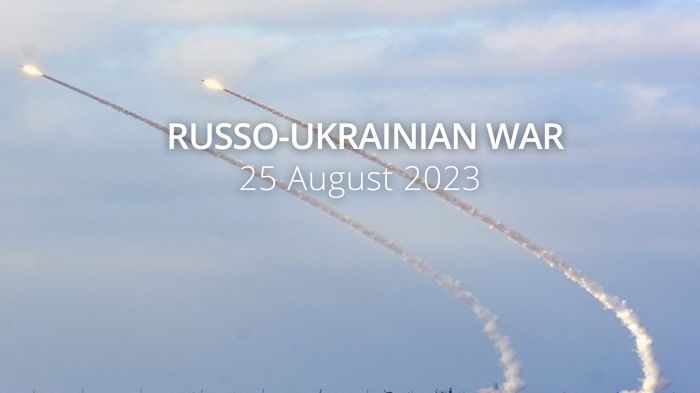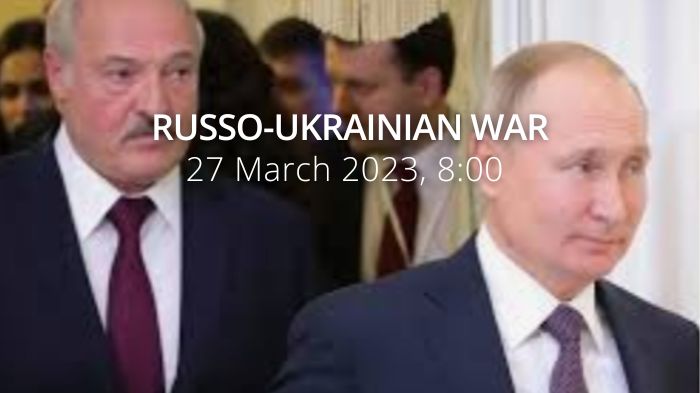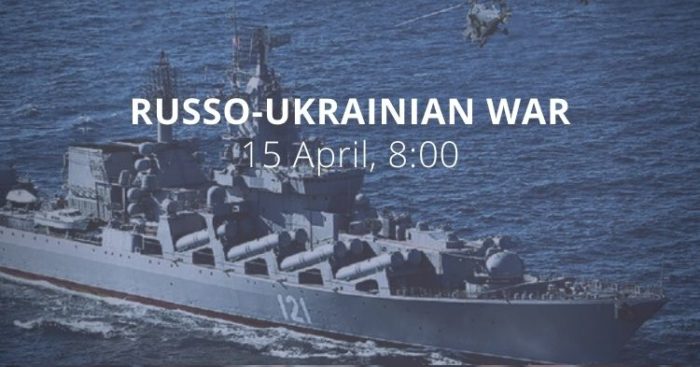Ukraine launches 42 drones on Crimea; Russia says all drones destroyed. Ukraine advances despite Russia’s desperate resistance in Donbas. Hungary wants EU to extend Ukrainian grains import ban beyond Sept 15.
Daily report day 548 – August 25 2023
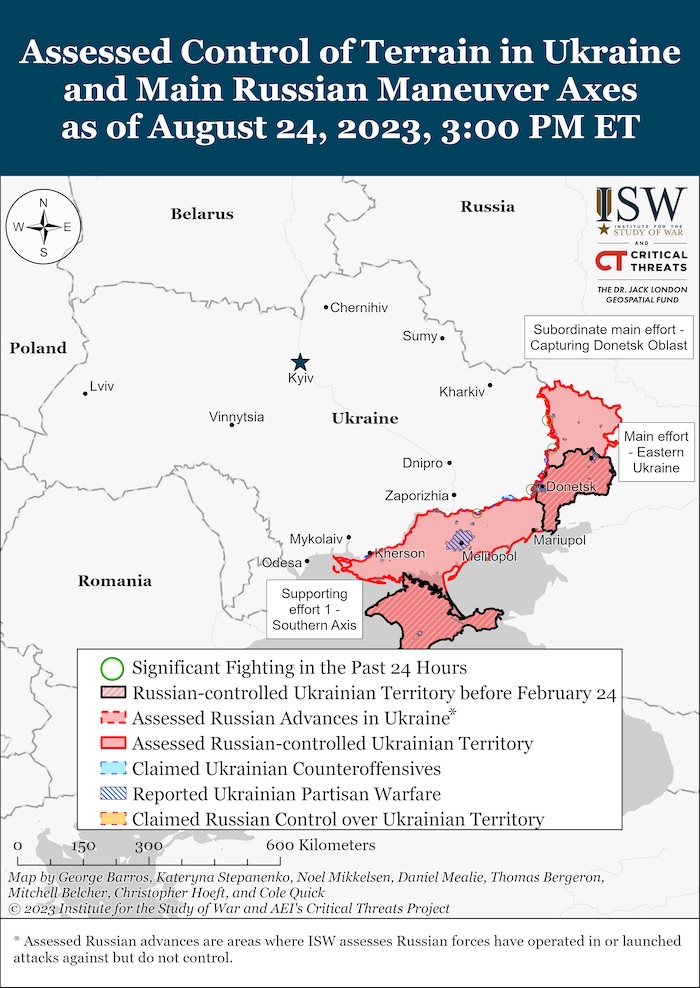
According to information from the General Staff as of 06.00 25.08.2023, supplemented by its [18:00 assessment].
“Last night, the Russian Federation launched yet another missile and airstrike on the territory of Ukraine. Information on the aftermath of this terrorist attack is currently being updated.
On August 24, the enemy launched 7 missiles and 47 airstrikes, 69 MLRS attacks at the positions of Ukrainian troops and various settlements. Unfortunately, the Russian terrorist attacks have killed and wounded civilians. Residential buildings and other civilian infrastructure were damaged.
The likelihood of missiles and airstrikes across Ukraine remains high.
On August 24, there were 3x combat engagements.
- Volyn and Polissya axes: no significant changes.
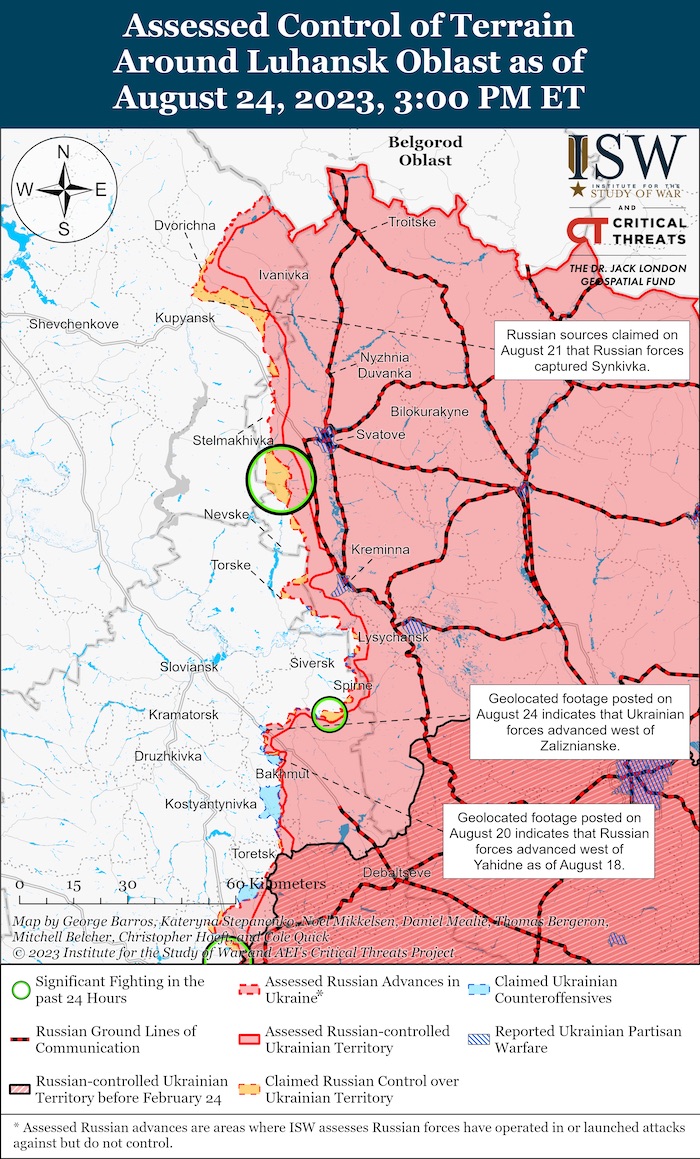
- Sivershchyna and Slobozhanshchyna axes: the adversary launched airstrikes in the vicinities of Bobylivka and Volfyne (Sumy oblast). The adversary fired mortars and artillery at more than 25 settlements, including Khrinivka, Tur’ya, Bleshnya, Yanzhulivka, Mykolaivka, Hai (Chernihiv oblast), Ob’jednane, Khodyne, Uhroidy, Novodmytrivka, Popivka (Sumy oblast), Chervona Zorya, Strilecha, Hatyshche, Mala Vovcha, Topoli (Kharkiv oblast).
- Kupiansk axis: the adversary conducted unsuccessful offensives in the vicinity of Novojehorivka (Luhansk oblast). The enemy launched airstrikes in the vicinities of Orlyans’ke (Kharkiv oblast), Nadiya, and Tverdokhlibove (Luhansk oblast). The settlements of Dvorichna, Syn’kivka, Ivanivka, Kyslivka, and Berestove (Kharkiv oblast) came under artillery and mortar fire from the adversary.
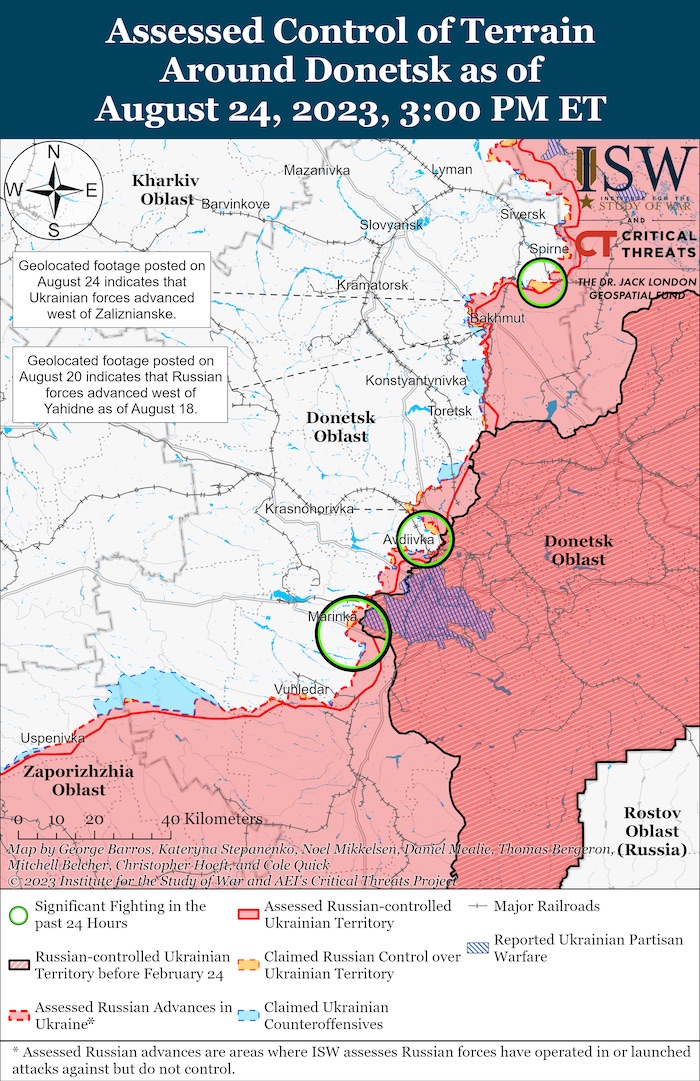
- Lyman axis: the adversary launched airstrikes in the vicinities of Spirne, Rozdolivka, and Vesele (Donetsk oblast). The adversary fired artillery and mortars at the settlements of Nevske, Bilohorivka (Luhansk oblast), Spirne, and Rozdolivka (Donetsk oblast).
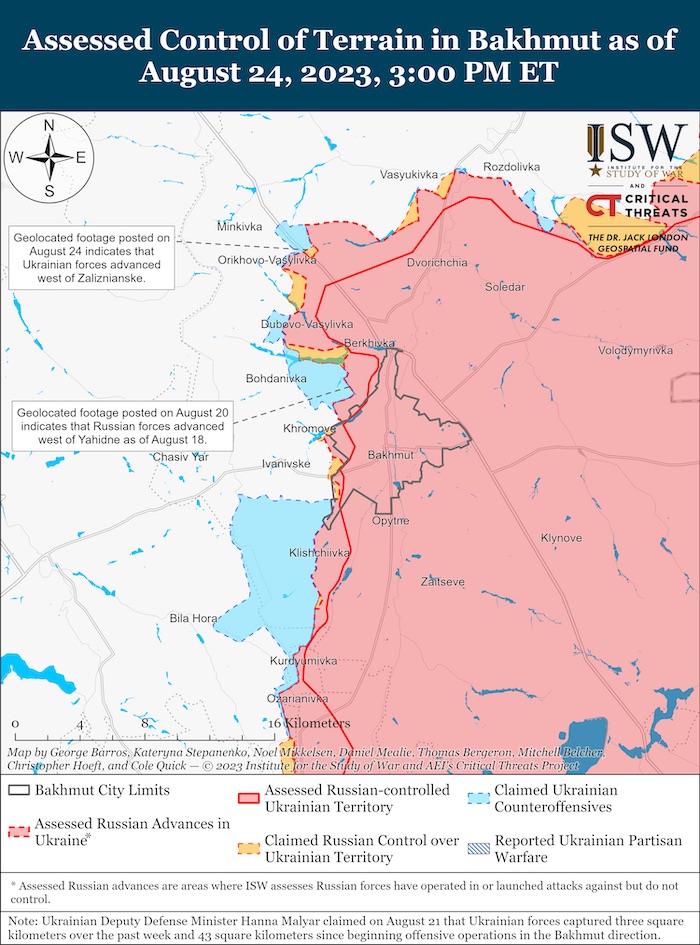
- Bakhmut axis: the adversary launched airstrikes in the vicinities of Ivanivske, Klishchiivka, and Bila Hora (Donetsk oblast). More than 10 settlements, including Vasyukivka, Min’kivka, Markove, Bakhmut, Ivanivske, and Klishchiivka (Donetsk oblast), suffered from enemy artillery shelling.
- Avdiivka axis: the adversary conducted unsuccessful offensive operations in the area south of Avdiivka (Donetsk oblast). The invaders fired artillery at more than 10 settlements, including Keramik, Berdychi, Vodyane, Karlivka, Netailove, and Nevel’s’ke (Donetsk oblast).
- Marinka axis: the Ukrainian Defence Forces continue to hold back the Russian offensive in the areas north-east of Novomykhailivka and Marinka (Donetsk oblast). The adversary launched an airstrike in the vicinity of Krasnohorivka (Donetsk oblast). The invaders fired artillery at the settlements of Zhelanne Pershe, Oleksandropil’, Pobjeda, Katerynivka, Yelyzavetivka, and Illinka (Donetsk oblast).
- Shakhtarske axis: the adversary launched airstrikes in the vicinities of Blahodatne and Staromaiors’ke (Donetsk oblast). More than 10 settlements, including Maksymivka, Shakhtars’ke, Velyka Novosilka, Urozhaine, Staromaiors’ke, and Vil’ne Pole (Donetsk oblast), suffered from enemy artillery shelling.
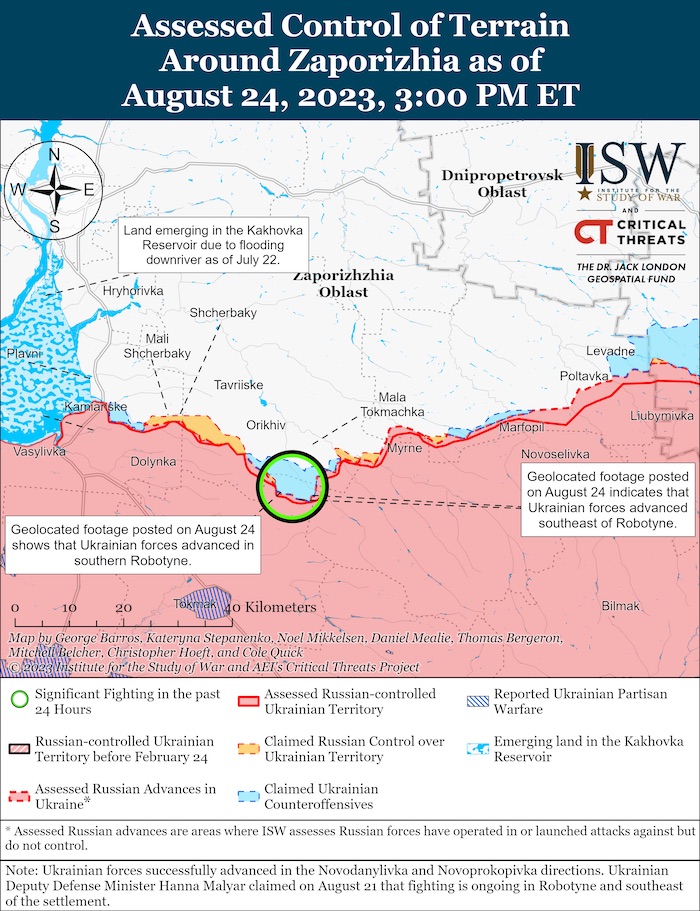
- Zaporizhzhia axis: the adversary launched airstrikes in the vicinities of Levadne, Mala Tokmachka, Robotyne, and Orikhiv (Zaporizhzhia oblast). More than 20 settlements suffered from enemy artillery shelling, including Levadne, Hulyaipole, Bilohir’ya, Mala Tokmachka, Stepove, and Plavni (Zaporizhzhia oblast).
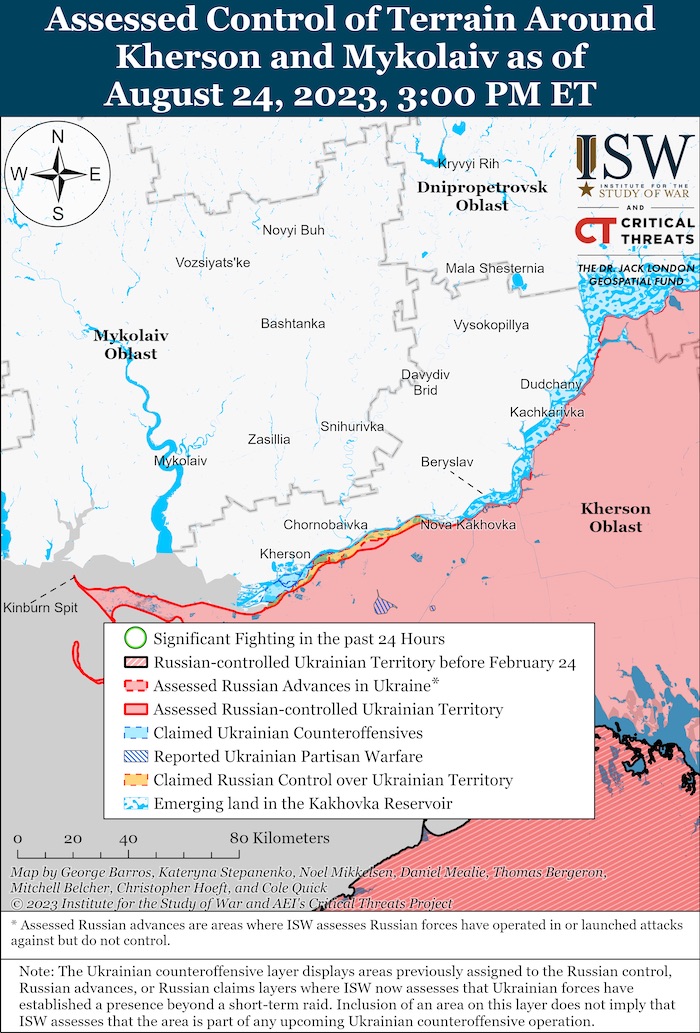
- Kherson axis: the adversary launched airstrikes in the vicinities of Tyahynka and Naddnipryans’ke (Kherson oblast). More than 20 settlements suffered from enemy artillery shelling, including L’vove, Kherson, Komyshany, Bilozerka, Kizomys, Posad-Pokrovs’ke (Kherson oblast), and Ochakiv (Mykolaiv oblast).
At the same time, the Ukrainian Defense Forces continue to conduct the offensive operation on Melitopol axis, consolidating their positions and conducting counter-battery fire.
Occupation authorities in one of the temporarily occupied settlements of Zaporizhzhia oblast took into account its negative experience of organizing a pseudo-referendum. Thus, it is planned to hold “elections” in a mixed format: demonstration voting at polling stations and visiting apartments and houses. The house-to-house visits are supposed to start in advance. Starting from August 30, 2023, representatives of the occupation authorities will start visiting apartments to collect votes. To add more votes, people are being brought in from the territory of Russia and settled in houses abandoned by locals in this area. This is related to preparations to rig votes and create the right image for the Russian media.
The locals are also increasingly pressured into obtaining Russian passports. In particular, Russian citizenship is a requirement being introduced to pay for utilities, the Internet, and mobile phones. Otherwise, it is impossible. In order to build pressure on the locals in this area, there is an increase in the number of military personnel of Chechen nationality. They behave very aggressively and are tough on locals who violate the curfew.
On August 24, the Ukrainian Air Force launched 1 airstrikes on a command post, 13 airstrikes on the concentrations of troops, and 3 airstrikes on the anti-aircraft missile systems of the adversary.
On August 24, the Ukrainian missile and artillery troops hit 2 command posts, 2 concentrations of troops, weapons, and military equipment, 5 artillery systems at their firing positions, 1 air defence asset, 1 ammunition depot, and 1 electronic warfare station of the adversary.“
Military Updates
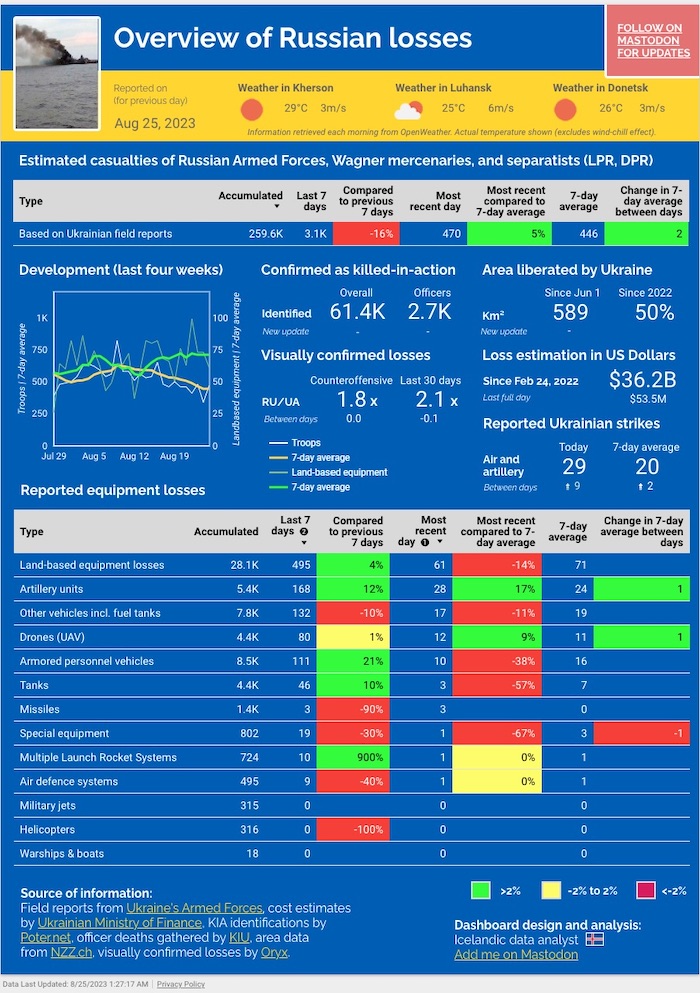
Russia says destroys 42 Ukraine-launched drones over Crimea, Reuters reports. “Russia’s air defence forces destroyed 42 Ukraine-launched drones over the Crimean Peninsula and one missile over the Kaluga region early on Friday, the Russian defence ministry [claimed]. The ministry said nine drones were destroyed by air defence forces while 33 were suppressed by electronic warfare and crashed over Crimea without reaching their targets. Russia annexed the peninsula from Ukraine in 2014. […]
There were no immediate reports of casualties or damage from the attacks, which Russia blamed on Ukraine. Russian airports suspended flights for a few hours. The number of drones launched was one the largest in a surge of similar attacks.”
Blasts rock occupied Crimea, Ukrinform reports, citing local Telegram channels. “Explosions rang out in several districts of the temporarily occupied Crimea. In particular, explosions were heard in Simferopol city and Simferopol district, as well as in Sevastopol, Saky, near Meganom and Tarkhankut capes. Drones were also spotted flying over Sevastopol and in Simferopol district.”
Ukraine advancing despite Russia’s desperate resistance in Donbas, Ukrinform reports, citing Deputy Minister of Defense Hanna Maliar. “The situation in the east of Ukraine remains difficult as the enemy forces are trying to advance in the Kupiansk direction and undertaking assault efforts near Lyman, while Ukraine’s troops are advancing in the conditions of the enemy’s desperate resistance on the Bakhmut axis.
In the Kupiansk direction, the enemy does not stop its attempts to advance. They are carrying out numerous attacks, trying to hit our infrastructure. Fighting continues. Our soldiers heroically repel the enemy and break all their plans. It is no less hot in the Lyman direction. There, the enemy made unsuccessful assault efforts with the aim of displacing our troops in the areas of Serebryansk Forestry, Kreminna, and Bilohorivka, Luhansk region. In addition, the enemy is currently planning to regroup and replace troops in this area. Active fighting is also going on in the Bakhmut direction, where the enemy is constantly attacking, using armoured vehicles and aviation. Their goal is to hamper our advance at any cost. At the same time, we are gradually advancing even in conditions of desperate resistance, Maliar said.
According to the official, the situation in all eastern directions is tense and dynamic. […] As Ukrinform reported earlier, as of August 21, some 43 square kilometres of Ukrainian land had already been liberated in the Bakhmut direction. The advance of Ukrainian troops has become notable along the southern flank around Bakhmut.”
Ukraine says it launched a ‘special operation’ in Russian-occupied Crimea, Reuters reports. “Ukraine’s navy and military intelligence carried out a “special operation” overnight in which units landed on Russian-occupied Crimea, the defence ministry’s [Defence Intelligence of Ukraine] (DIU) said on Thursday. The operation, which Reuters was unable to independently confirm, would amount to a rare demonstration that Ukrainian forces are able to stage ground operations in Crimea, which Russia seized and annexed in 2014.
Brief and dark video footage posted alongside the statement showed a small motorboat moving through the water at night near a coastline. [DIU] said the landing point was on the western tip of Crimea, near the settlements of Olenivka and Mayak. […] It said “all goals” had been achieved and casualties inflicted on the enemy, but did not identify the goals. Also, the state flag flew again in Ukrainian Crimea, it said, without saying where exactly or providing further details.”
In addition to S-400 “Triumph” in Crimea, Defence Forces yesterday also damaged 3 Russian S-300s in the Kherson region, Censor.net reports, citing “Facty“, quoting Natalia Humeniuk, spokeswoman for the Defence Forces of the South. “In addition to the S-400 “Triumph” in Crimea, the Defence Forces also damaged 3 Russian S-300s in the Kherson region yesterday, but the Russians still have many weapons that need to be destroyed. […] She noted that it is still too early to draw conclusions, because there is a lot of work ahead.
We will remind you that the Russian S-400 “Triumph” complex was destroyed yesterday in the occupied Crimea.”
According to British Defence Intelligence, (last 48 hours):
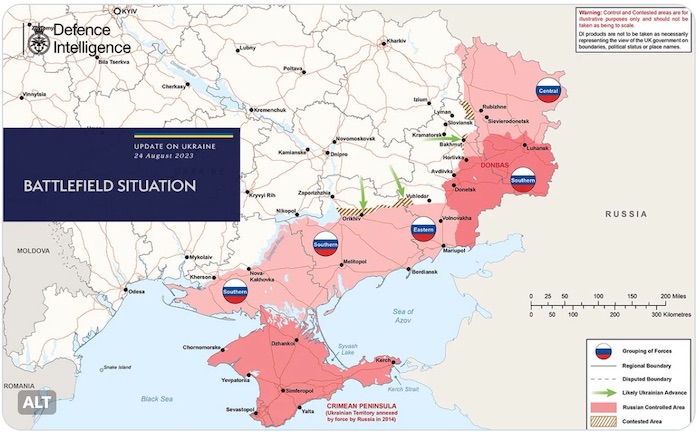
- On 23 August 2023, exactly two months after the Wagner Group’s mutiny, a Wagner-associated Embraer business jet crashed near Tver, between Moscow and St Petersburg. The Russian authorities claim 10 people on board died, including Wagner owner Yevgeny Prigozhin. There is not yet definitive proof that Prigozhin was onboard and he is known to exercise exceptional security measures. However, it is highly likely that he is indeed dead.
- The demise of Prigozhin would almost certainly have a deeply destabilising effect on the Wagner Group. His personal attributes of hyper-activity, exceptional audacity, a drive for results and extreme brutality permeated Wagner and are unlikely to be matched by any successor.
- Wagner’s leadership vacuum would be compounded by the reports that founder and field commander Dimitry Utkin and logistics chief Valery Chekalov also died.
- On 19 August 2023, President Vladimir Putin made a rare visit to Southern Military District HQ at Rostov-on-Don, approximately 160km from the front line.
- The HQ hosts the staff running the war in Ukraine.
- Putin held a meeting with senior officers, including Chief of the General Staff General Valery Gerasimov who continues to command the operation in Ukraine.
- Wagner Group briefly seized the HQ in June 2023. Putin highly likely wishes to project his authority and to portray the senior military command as functioning as usual.
Losses of the Russian Army
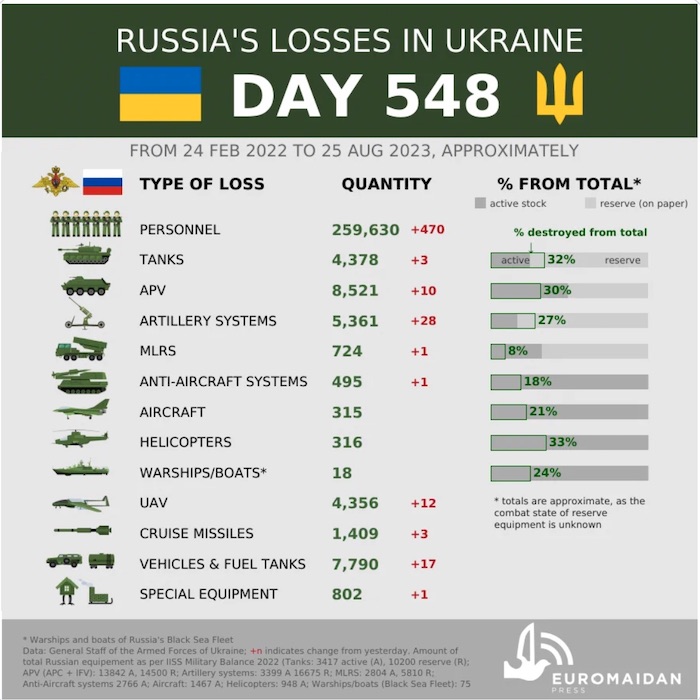
As of Friday 25 August, the approximate losses of weapons and military equipment of the Russian Armed Forces from the beginning of the invasion to the present day:
- Personnel – about 259630 (+470)
- Tanks – 4378 (+3)
- Armoured combat vehicles – 8521 (+10)
- Artillery systems – 5361 (+28)
- Multiple rocket launchers –MLRS – 724 (+1)
- Air defence means – 495 (+1)
- Aircraft – 315 (+0)
- Helicopters – 316 (+0)
- Automotive technology and fuel tanks – 7790 (+17)
- Vessels/boats – 18 (+0)
- UAV operational and tactical level – 4356 (+12)
- Special equipment – 802 (+1)
- Mobile SRBM system – 4 (+0)
- Cruise missiles – 1409 (+3)
Ukraine’s Intelligence chief says how many strategic bombers remain operational in Russia after Ukraine’s recent attacks, Euromaidan Press reports. “Head of Ukraine’s Intelligence, Kyrylo Budanov, said in an interview with Radio Free Europe that Russia has only 27 TU-22 strategic bombers that are still operational. Recent Ukrainian attacks on two Russian airfields destroyed two and damaged two more bombers. According to Budanov, 436 Russian aircraft in total are participating in air operations against Ukraine. […] According to him, during operations at the Russian military airfields Soltsy (Nizhny Novgorod Oblast) and Shaykovka (Kaluzya Oblast), two TU-22 planes were completely destroyed, and two more were damaged.
The two damaged ones will be repaired over time, this must also be understood, Budanov emphasized. Still, he said, the operation will decrease Russia’s ability to fire X-22 cruise missiles against Ukraine. This is especially crucial during the approaching heating season when Russia will try to destroy Ukraine’s energy system again.
According to Budanov, in the recent operation, “certain people conducted certain actions from the territory of the Russian Federation,” destroying TU-22 bombers. On 19 August, the Russian Ministry of Defense said there was a drone attack on the Soltsy military airfield in the Novgorod region. […] Presumably, drone operators launched drones from a close distance near the airfield. This version is especially relevant given that unknown persons raised the flag of Ukraine right next to the local FSB office after the attack.
Earlier, in December 2022, Ukraine attacked Russian strategic air bases in the city of Engels and the Ryazan region. Recently, drones have also been attacking Russian territories, in particular Moscow.”
Over 20% of Russian Aerospace Force losses self-inflicted, Ukrinform reports, citing Newsweek. “More than a fifth of the losses of Russian warplanes and helicopters since the full-scale invasion of Ukraine were non-combat-related but due to equipment malfunctions, pilot errors, and friendly fire. The publication used open-source intelligence data from Oryx, as well as public reports from the Russian media.
According to Oryx, as of August 17, Russia has lost 186 aircraft and helicopters, of which 13 are designated as “non-combat” losses. Newsweek was able to confirm the destruction of 221 manned aircraft, including 17 jets and 18 helicopters – a total of 48 units considered non-combat-related losses. Among them are seven Su-25 aircraft, four MiG-31 supersonic interceptors, and three Ka-52 Alligator reconnaissance attack helicopters.
Although these figures are by no means exhaustive, they still offer a dire assessment of the current situation of the Russian Aerospace Force, the publication notes. […] Experts consider poor pilot training in Russia to be one of the reasons behind such stats.”
Ukraine’s Defence Intelligence lured Russian Mi-8 helicopter into Ukraine, Ukrainska Pravda reports. “Recently, a Mi-8 helicopter of the Russian Armed Forces ended up in Ukraine as a result of a long-term special operation of the Main Intelligence Directorate of the Armed Forces of Ukraine. This happened as a result of a special operation of the Main Intelligence Directorate, which lasted more than 6 months. Ukrainian intelligence lured a pilot of a Mi-8 AMTSh to Ukraine. The helicopter crew made a flight between two air bases and transported parts for Su-27 and Su-30 fighter jets.
Along with the pilot on board were two crew members who did not know where the helicopter was actually flying. The Mі-8 landed in Kharkiv Oblast. As a result of the special operation, two crew members were eliminated. The pilot remained in Ukraine, and his family was taken there in advance. Now, the pilot and his family are in Ukraine. The Mі-8 stayed in Ukraine, along with the fighter jets parts.”
Humanitarian
Hungary wants EU to extend Ukrainian grains import ban beyond Sept 15, Reuters reports. “Hungary wants the EU’s ban on domestic sales of Ukrainian grain to be extended in the five EU member states bordering Ukraine after the current measure ends on Sept. 15, Prime Minister Viktor Orban’s chief of staff told a briefing on Thursday. “Hungary will ask the EU to extend the ban from September 16,” Gergely Gulyas said, adding Hungary was ready to reimpose a national import ban if the EU does not extend the measure.
The European Union in May allowed Bulgaria, Hungary, Poland, Romania and Slovakia to ban domestic sales of Ukrainian wheat, maize, rapeseed and sunflower seeds, while permitting transit of such cargoes for export elsewhere. This ban is set to expire on Sept. 15. Poland has said it would not lift the ban even if the EU does not agree on its extension.
Before the EU measure, the central European countries imposed unilateral bans early this year on Ukrainian grain imports to protect their domestic producers, after a surge in Ukrainian grain exports into the five states in 2022 and early 2023. The current EU deal to protect farmers in the five states is due to expire next month and the central European countries want it to be extended at least until the end of the year.”
Norway allocates NOK 1.5B to ensure Ukraine’s electricity, gas imports, Ukrinform reports, citing by the Ukrainian Energy Ministry. “The Government of Norway is allocating NOK 1.5 billion via the European Bank for Reconstruction and Development (EBRD) to ensure the import of natural gas and electricity to Ukraine. The funds will be directed to critical energy infrastructure repairs and technical maintenance, and emergency power supply in the regions affected by hostilities, as well as natural gas purchases for emergency storage purposes, the report states.
According to the ministry, this was announced by Prime Minister of Norway Jonas Gahr Støre during his visit to one of Ukrainian energy facilities, which had been affected by repeated Russian attacks.”
Environmental
Russians attack Ukrainian TPP, suspending operations, Ukrainska Pravda reports, citing DTEK’s press service. “A Russian attack on Thursday has caused serious damage to a thermal power plant (TPP) belonging to DTEK Energo [the largest private investor in Ukraine’s power systems – ed.], as a result of which it has suspended electricity production. Fortunately, there were no casualties, the company added. As for the TPP, the company’s equipment was seriously damaged.
Once the bombardment stops, the power company will be able to start repairing the damage and repairing the equipment. The company is synchronising its actions with Ukrenergo, Ukraine’s national energy company. It is noted that this TPP has been attacked several times before. Since September last year, DTEK Energo’s power plants have been attacked 34 times in total. The attacks killed 3 engineers and injured 28. Independent contractors and rescue workers were also killed and injured.”
Support
Norway to Send F-16 Fighters to Ukraine, European Pravda reports, citing TV 2. “Norway has decided to send F-16 fighters to Ukraine. Prime Minister Jonas Gahr Støre is currently on an official visit to Kyiv, the channel adds. Norway becomes the third country, following the Netherlands and Denmark, to provide Ukraine with F-16s. The country has a total of 57 such aircraft.
Denmark and the Netherlands announced over the weekend their decision to send these aircraft to Kyiv after training. Ukrainian pilots have begun training on F-16fighters in Denmark. It has also been revealed that Greece will join in the training of Ukrainians on F-16s.”
Top US general says Ukraine to get F16 jets soon, Reuters reports. “The United States’ top general said on Thursday that Ukraine was likely to get F-16 fighter jets soon and said its counter-offensive against the Russian invasion has been going slowly and had partial success. Chairman of the Joint Chiefs of Staff Mark Milley said it was too early to say whether the counter-offensive had failed.
F-16s. That is moving forward, actually. So there’s a training program in place and they’ll likely receive F-16s … in the not-too-distant future, Chairman of the Joint Chiefs of Staff Mark Milley said in an exclusive interview with Jordan’s Al-Mamlaka public service TV news channel. […]
Washington was still deliberating providing long-range Army Tactical Missile Systems known as ATACMS that Ukraine wants and which reach behind enemy lines, including Russia, Milley told Al-Mamlaka. They’ve gotten long-range artillery with the Guided Multiple Launch Rocket System (GMLRS) and the Brits have provided other types of capabilities that other countries have as well. So they’ve gotten a lot of artillery, he said. But the ATACMS is a controversial topic. And for a lot of reasons, they haven’t received those yet. They’re still on the table. President Biden has not said no or yes at this time, Milley said.”
Ukrainian pilots to receive F-16 training in US, Reuters reports. “The United States will begin flight training for Ukrainian pilots on F-16 fighter jets in October, the Pentagon announced on Thursday.
The training will begin after the pilots receive English language training next month, Pentagon spokesman Brigadier General Pat Ryder said. The flight training will take place in Arizona, Ryder added. Several pilots and dozens of aircraft maintenance crew will take the training, Ryder added.”
Germany transfers missiles for Patriot system to Ukraine, Ukrinform reports, citing the website of the German government. “Today, August 24, Germany has published an updated list of a military aid package for Ukraine. Germany, for the first time, sent Ukraine missiles for the Patriot air defence system – this follows from the list of equipment Berlin transferred in the past week. In addition to missiles for Patriot systems, over the past week, Ukraine also received ten drone detection systems, 40 reconnaissance drones RQ-35 HEIDRUN, 16 156 trucks Zetros, and 510,000 rounds of ammunition for firearms.
Germany also announced that it plans to transfer to Ukraine in the future: 90 drone detection systems; 42 trucks Zetros; 31 million rounds of ammunition for firearms. The government said deliveries are coming from industry stocks financed by German funds for security capacity building.”
Baykar gifts combat drone to Ukrainian intel on occasion of Independence Day, Ukrinform reports, citing the Defence Intelligence of Ukraine. “Baykar Makina has congratulated Ukraine on Independence Day. On August 24, the Ukrainian intelligence received the Bayraktar TB2 unmanned combat aerial vehicle (UCAV) as a gift from the manufacturer of famous drones, the report states.”
Ukraine has every right to attack territory of Russian Federation, – Senator Blumenthal, Censor.net reports, citing Ukrinform, quoting US Senator Richard Blumenthal at a press conference in Kyiv. “Ukrainians are attacking Russia on its territory with Ukrainian weapons. How can we ask Ukrainians about the use of their weapons while sitting in a bunker? After I visited Bucha, where the Russians killed women and children with their hands tied by shooting them to the head by the hundreds, I cannot forgive the Russian military for this. I believe that Ukrainians have an absolutely complete moral right to do what they do, he emphasized.
The senator noted that Ukrainians live under constant attacks, so it is necessary to help Ukraine with air defence systems. The Biden administration is ready to provide more air defence systems, but the problem is the need to manufacture these weapons. We need to encourage suppliers to fulfil production orders sooner, Blumenthal added.
The senator also emphasized the need to speed up pilot training for the F16. In his opinion, these fighters will change the rules of the game on the battlefield.”
Zelenskyy: Military command asked me to give them opportunity to mobilise more people, Ukrainska Pravda reports, citing President Zelensky at a press conference within the framework of the Crimean Platform. “The journalist asked the head of state whether there would be an increase or acceleration of mobilisation, given the counter-offensive and losses, and whether everyone would have to serve in the army. The president did not give a direct answer. Frankly speaking, the military command addressed me to give them the opportunity to mobilise more… That’s it. I can’t tell you anything else yet.
On 11 August, President Volodymyr Zelenskyy held a meeting of the National Security and Defence Council, the main topic of which was the results of the inspection of territorial recruitment and social support centres. Zelenskyy also announced a decision on military medical commissions, as there are many issues due to the poor quality of the work of the military medical commissions.
On 17 August, Zelenskyy signed a decree with recommendations from the National Security and Defence Council of Ukraine to Valerii Zaluzhnyi, the Commander-in-Chief of the Armed Forces of Ukraine, to dismiss all regional military enlistment officers. On 22 August, law enforcement officers conducted more than 200 searches of medical facilities and territorial recruitment centres across the country.
As a result of more than 200 searches in recruitment centres, the National Police seized more than 10,000 medical files to record corruption schemes for draft evasion.”
New developments
- Zaluzhny saying Ukrainian army on cusp of a breakthrough, Ukrinform reports, citing Wall Street Journal. “US and Ukrainian officials have been engaged in an intense behind-the-scenes debate for weeks over the strategy and tactics of Ukraine’s counteroffensive. American military officials have been urging the Ukrainians to return to the combined arms training they received at allied bases in Europe by concentrating their forces to try to bust through Russia defenses and push to the Sea of Azov. The American advice is based on the calculation that the surge of equipment the US has funnelled to Ukraine is enough for this offensive and is unlikely to be repeated at anywhere near the same level in 2024. However, it isn’t too late for Ukraine to make gains, according to US officials. Commander-in-Chief of the Armed Forces of Ukraine Valeriy Zaluzhny has told US officials that the Ukrainian army is on the cusp of a breakthrough. Yet deep divisions over the strategy linger. The US for the past several weeks has urged the Ukrainians to mass their forces and concentrate in an area north of Tokmak in the south to push through the first line of Russian defenses, generally acknowledged as the toughest line to break, and not to waste efforts in Bakhmut direction.”
- US imposing sanctions over forced deportation, transfer of Ukraine children, Reuters reports. “The US State Department on Thursday imposed sanctions on 13 people and entities it said are reportedly connected to the forced deportation and transfer of Ukraine’s children, as Washington ramps up pressure on Moscow over its invasion. The United States is also taking steps to impose visa restrictions on three Russia-installed purported authorities over their involvement in human rights abuses of Ukrainian minors, the State Department said in a statement. The sanctions coincided with Ukraine’s Independence Day. The United States will not stand by as Russia carries out these war crimes and crimes against humanity, US Ambassador to the UN Linda Thomas-Greenfield told a UN Security Council meeting on Ukraine on Thursday. Ukraine’s government estimates that Russian authorities have deported and/or forcibly displaced over 19,500 children from their homes since Russia’s 2022 invasion of Ukraine.”
- Decisions on negotiations regarding Ukraine’s accession to EU can be made in December, Censor.net reports, citing RBC-Ukraine, quoting Deputy Prime Minister for European and Euro-Atlantic Integration of Ukraine Olga Stefanishyna. “A decision on the start of negotiations on Ukraine’s membership in the EU can be made at the summit in Brussels in December. Such a decision is being made today at the level of leaders. The closest opportunity to make such a decision will be at the end of the year in December, when all the leaders of the 27 EU countries will gather in Brussels, she said. According to her, for this, Ukraine needs to complete the implementation of seven recommendations, which were provided by the European Commission before receiving candidate status. Again, in October we will receive an assessment of the progress on political reforms. We hope that our work now, both parliamentary and governmental and the leadership of the president, who is at the forefront of this process, will allow us to receive a recommendation from the European Commission on the possibility of opening negotiations, the deputy prime minister added.”
Assessment
- On the War
The Institute for the Study of War has made the following assessment as of Wednesday 23 August:
(quote) “Russian forces conducted offensive operations along the Kupiansk-Svatove-Kreminna line on August 24 and reportedly advanced. The Ukrainian General Staff reported that Russian forces conducted unsuccessful offensive operations near Novoyehorivka (15km southwest of Svatove). Ukrainian Deputy Defense Minister Hanna Maliar reported that Russian forces unsuccessfully attacked near the Serebryanske forest area (10km southwest of Kreminna), Kreminna, and Bilohorivka (12km south of Kreminna) and that Russian forces plan to regroup and replace troops in the Lyman direction. A Russian milblogger claimed that Russian forces control most of Synkivka (8km northeast of Kupiansk). Some Russian milbloggers claimed on August 23 that Russian forces are advancing on Bilohorivka and control the road to Hryhorivka (11km south of Kreminna) from Bilohorivka, but ISW has not observed visual confirmation of this claim. A Russian milblogger claimed that positional battles are ongoing near Torske and the Serebryanske forest area.
Russian officials claimed that Ukrainian forces conducted offensive operations along the Kupiansk-Svatove-Kreminna line but did not advance on August 24. The Russian MoD and Russian Central Grouping of Forces Spokesperson Alexander Savchuk claimed that Ukrainian forces unsuccessfully attacked near Synkivka, Novoselivske (14km northwest of Svatove), Hryhorivka, Novoyehorivka, Torske, Dibrova (7km southwest of Kreminna), the Serebryanske forest area, and Berestove (30km south of Kreminna).
Ukrainian forces continued counteroffensive operations in the Bakhmut direction on August 24 and advanced north of Bakhmut. Geolocated footage published on August 24 indicates that Ukrainian forces advanced west of Zaliznyanske (12km northwest of Bakhmut). The Ukrainian General Staff reported that Ukrainian forces continued offensive operations south of Bakhmut. Ukrainian Deputy Defense Minister Hanna Maliar stated that Ukrainian forces continue to gradually advance in the Bakhmut direction. A Russian milblogger claimed that Ukrainian forces made unspecified advances near Klishchiivka (7km southwest of Bakhmut) and captured Russian forward positions west of the settlement. The Russian Ministry of Defense (MoD) reported that elements of the Russian Southern Grouping of Forces repelled Ukrainian assaults near Pivnichne (21km southwest of Bakhmut).
The Ukrainian General Staff reported that Russian forces unsuccessfully counterattacked north of Bakhmut near Vesele (19km north of Bakhmut) on August 24.
The Russian MoD claimed that Ukrainian forces conducted limited unsuccessful ground attacks near Nevelske (14km southwest of Avdiivka) on August 24.
Russian forces continued limited offensive operations along the Avdiivka-Donetsk City front on August 24 but did not advance. The Ukrainian General Staff reported that Ukrainian forces repelled Russian assaults south of Avdiivka, near Marinka (27km southwest of Avdiivka), and northwest of Novomykhailivka (36km southwest of Avdiivka). A Russian milblogger also claimed that Russian assaults in Marinka and south of Avdiivka were unsuccessful.
Russian sources claimed that Ukrainian forces continued offensive operations in the Donetsk-Zaporizhzhia Oblast border area on August 24 but did not make any confirmed advances. The Russian MoD claimed that elements of the Russian Eastern Grouping of Forces repelled a Ukrainian attack near Pryyutne (16km southwest of Velyka Novosilka). Russian sources claimed that Ukrainian forces unsuccessfully attacked near Pryyutne and Staromlynivka (15km south of Velyka Novosilka). Another Russian milblogger claimed that Ukrainian forces control Urozhaine (9km south of Velyka Novosilka) but that the speed of Ukrainian advances in the area has slowed.
Ukrainian forces continued counteroffensive operations in western Zaporizhzhia Oblast on August 24 and advanced closer to Russian secondary defensive lines. Geolocated footage published on August 24 indicates that Ukrainian forces advanced in southern Robotyne (10km south of Orikhiv). Additional geolocated footage published on August 24 indicates that Ukrainian forces also advanced east of Robotyne towards Verbove (18km southeast of Orikhiv). The Ukrainian General Staff reported that Ukrainian forces achieved unspecified success in the direction of Novodanylivka (5km south of Orikhiv) and Novoprokopivka (13km south of Orikhiv). Russian milbloggers claimed that Ukrainian forces continued to advance near Robotyne and towards Novopokropivka on the evening of August 23. Some Russian sources claimed on August 24 that Russian forces repelled Ukrainian attacks near Novoprokopivka, however. Russian sources claimed that Ukrainian forces conducted armored attacks in southern Robotyne and east of the settlement. Russian milbloggers claimed that Ukrainian forces only control the northern part of Robotyne and one Russian milblogger claimed that neither side controls central Robotyne. Another Russian milblogger claimed that Ukrainian forces control most of the settlement, however. The Russian MoD claimed that Russian forces repelled five Ukrainian attacks near Robotyne and near the Balka Uspenivka area (11km southeast of Orikhiv).
Russian forces continued ground attacks in western Zaporizhzhia Oblast on August 24 but did not advance. The Ukrainian General Staff reported that Russian forces conducted unsuccessful offensive operations near Mala Tokmachka (9km southeast of Orikhiv). A Russian source claimed that Russian forces counterattacked in Robotyne and pushed Ukrainian forces from the northern part of the settlement.
Ukrainian forces continued limited raids on the east (left) bank of the Dnipro River in Kherson Oblast on August 24. Ukrainian Southern Operational Command posted footage and reported that Ukrainian forces temporarily raised a large flag on the east (left) bank of the Dnipro River in Kherson Oblast. Russian sources claimed that Russian forces struck several Ukrainian sabotage and reconnaissance groups that landed on unspecified islands in the Dnipro River delta and repelled several groups attempting to land on the east (left) bank between Hola Prystan (10km southwest of Kherson City) and Kardashynka (7km south of Kherson City). A Russian milblogger claimed that Ukrainian forces maintain limited positions near Oleshky (8km southeast of Kherson City) and the Antonivsky Bridge.
Some Russian sources claimed that Ukrainian forces struck the command post of an unspecified element of the Russian 58th Combined Arms Army (Southern Military District) in Tokmak on August 24.
Russian forces reportedly struck a Ukrainian S-300 air defense system in Mykolaiv Oblast. Russian sources, including the Russian MoD, claimed that Russian airstrikes destroyed two missile launchers, a radar station, and the command-and-control center of a Ukrainian S-300 system near Zelenyi Hai (13km east of Mykolaiv City), Mykolaiv Oblast. […]
The Wagner Group will likely no longer exist as a quasi-independent parallel military structure following Russian President Vladimir Putin’s almost certain assassination of Wagner financier Yevgeny Prigozhin, Wagner founder Dmitry Utkin, and reported Wagner logistics and security head Valery Chekalov on August 23. The death of Wagner’s central leadership disrupts Wagner’s ability to reverse the effects of the Kremlin’s and the Russian Ministry of Defense’s (MoD) campaign to weaken, subsume, and destroy the organization following the June 24 armed rebellion. The Russian MoD has reportedly established private military companies (PMCs) that have been recruiting current and former Wagner personnel to assume control over Wagner’s operations abroad. Russian sources claimed that the Kremlin refused to pay the Belarusian government for Wagner’s deployment to Belarus and that financial issues were already leading to reduced payments that were causing Wagner fighters to resign. Satellite imagery from August 1 and 23 shows that Wagner had dismantled almost a third of the tents at its camp in Tsel, Asipovichy, Belarus in the previous month, suggesting that the effort to weaken Wagner may have resulted in a notable flight of Wagner personnel from the contingent in Belarus. Some milbloggers denied claims that Wagner fighters are dismantling their camp in Tsel, however. The Ukrainian Resistance Center reported on August 23 that an unspecified number of Wagner personnel at camps in Belarus began preparations to return to Russia following Prigozhin’s death. The central Wagner leadership had brought Wagner to the height of its independence during the offensive to capture Bakhmut and was attempting to retain some semblance of that independence in the aftermath of Wagner’s rebellion. The elimination of this central leadership likely ends any remaining means Wagner had to operate independently of the Russian MoD. It remains unclear whether the Kremlin intends for Wagner to completely dissipate or intends to reconstitute it as a much smaller organization completely subordinate to the Russian MoD. A third option—restoring Wagner as a quasi-independent organization under a new commander loyal to the Kremlin—is possible but unlikely.
Putin delivered a brief de facto eulogy of Prigozhin and reportedly deceased Wagner leadership on August 24, and portrayed Prigozhin as his loyal subordinate up until his death, the armed rebellion notwithstanding. Putin characterized Prigozhin as having a “difficult fate” in which he made “serious mistakes,” and Putin noted that he had known Prigozhin since the early 1990s. Putin notably stated that Prigozhin “achieved the necessary results both for himself and what I [Putin] asked him for – for a common cause, as in these last months.” Putin’s comment implies that Prigozhin had been fulfilling Putin’s orders recently and throughout their acquaintance and notably refrains from suggesting that Prigozhin had ever betrayed Putin, but subtly indicates that Prigozhin’s loyalty through the years was not enough to offset the “serious mistake” of launching a rebellion against the Russian military leadership. Putin’s speech largely confirms ISW’s prior assessment that Prigozhin did not intend to oust Putin during his June 24 rebellion and instead saw himself as loyal to Putin while seeking to force Putin to fire the Russian military leadership as he had been demanding. A Russian insider source, citing an unnamed individual who knew Prigozhin, claimed that Prigozhin was confident that Putin would forgive him. Prigozhin likely underestimated how seriously his rebellion had personally humiliated Putin. Prigozhin had also apparently overestimated the value of his own loyalty to Putin. Putin places significant value on loyalty and has frequently rewarded loyal Russian officials and military commanders even when they have failed. Prigozhin’s rebellion was an act of significant insubordination despite his claim that he rebelled out of loyalty to Russia. Putin’s statement was therefore a warning to those currently loyal to Putin that some mistakes are too serious for loyalty to overcome.
The exact cause of Prigozhin’s plane crash remains unclear as US and Russian sources offered varying explanations, while Wagner-affiliated channels continued to call on Russian sources to stop speculating. US officials have provided different preliminary unconfirmed explanations for the plane crash: surface-to-air missiles, a bomb aboard the aircraft, or other sabotage. Pentagon Spokesperson Brigadier General Patrick Ryder stated that the Pentagon currently has no indication that a surface-to-air missile downed the plane. Russian state news outlet Kommersant reported on August 23 that sources close to the Russian Investigative Committee stated that there is no reason to believe that a terrorist attack downed Prigozhin’s plane, contradicting a Russian official who immediately blamed terrorism. A Russian insider source previously reported that Russian authorities are setting conditions to blame the attack on terrorism. The Russian information space largely continued to speculate about the potential causes of the crash, including mechanical failure, sabotage, surface-to-air missiles, and air-to-air missiles but noted the lack of information from Russian officials. Some sources claimed that Russian authorities are investigating the possibility of an explosive device planted on the wing or landing gear, and one insider source claimed that Russian authorities are investigating Prigozhin’s personal pilot and the cofounder of MNT Aero, which owned the plane. Many Wagner-affiliated channels tried to minimize this speculation by calling on the information space to wait until confirmed Wagner sources publish official information.
The Wagner Council of Commanders have notably not released a public statement following the downing of Prigozhin’s plane. A Russian news aggregator claimed that the Wagner Council of Commanders met on the evening of August 23 to prepare a joint statement and announce what would happen to Wagner in the near future. The Wagner Council of Commanders has not released any statement as of this publication, and several Wagner-affiliated sources emphasized that circulating reports about the contents of the expected statement are false. The Wagner Council of Commanders’ silence may be due to chaos and confusion within their ranks following Prigozhin’s and Utkin’s assassination or due to explicit instructions from Russian authorities to remain silent. The Kremlin may view a public statement from the Wagner Council of Commanders as an attempt to organize and reconstitute an independent Wagner force that could continue to threaten the Kremlin and the Russian MoD. Putin’s willingness to publicly assassinate the Wagner leadership is likely prompting the Wagner Council of Commanders to refrain from publicly appointing successors to Prigozhin and Utkin at this time. A member of the Wagner Council of Commanders personally selected by Putin to replace Prigozhin now would risk becoming the focus of the ire of Wagner rank and file upset about the assassination of Wagner’s leadership.
Putin’s almost certain assassination of Wagner’s leadership has made it very clear that the Kremlin will be outwardly hostile to those who attempt to secure independence for their own parallel military structures. ISW previously assessed that Putin’s demonstrative assassination of Wagner’s leadership was meant to reassert his dominance and exact vengeance for the humiliation of Wagner’s rebellion, and specific individuals who may have planned to oppose Putin, the Kremlin, or the MoD likely took note. The Kremlin will likely view any future efforts to establish independent parallel military structures explicitly through the prism of its experience with Wagner and Prigozhin. The assassination of Wagner’s leadership will likely serve as a standing threat against those with designs on creating parallel military structures reminiscent of Wagner.
The June 24 agreement between Putin, Prigozhin, and Belarusian President Alexander Lukashenko was likely invalidated by the destruction of Prigozhin’s aircraft, and Lukashenko will likely remain silent on the matter to avoid provoking Putin and further risking his already vulnerable position. Prigozhin’s safety and survival were likely crucial to the June 24 agreement in which Putin allegedly promised unspecified “security guarantees” to Prigozhin and the Wagner Group in Belarus. Prigozhin’s death likely canceled a key pillar of this agreement, rendering the rest of it moot. Lukashenko will likely remain silent on the matter so as to not provoke Putin, especially since Lukashenko’s act of directly negotiating with Prigozhin in June and then bragging about the role he had played notably embarrassed Putin. Prigozhin’s assassination has likely signaled to Lukashenko both a dramatic reduction of his negotiating space with the Kremlin and an implicit threat against his continued attempts to resist Union State integration efforts.
Putin may avoid making Prigozhin a martyr, but Utkin’s assassination will likely become a long-term grievance for Wagner personnel. ISW had long assessed that Putin refrained from eliminating Prigozhin out of fears of angering Wagner personnel, and he may have determined that he had sufficiently separated Wagner from Prigozhin in the months since the rebellion and could assassinate Prigozhin without prompting a serious backlash. Putin’s likely calculus for killing Utkin probably focused more on the immediate opportunity to destroy Wagner’s leadership completely and less on the ramifications of Utkin’s death. There has been an outpouring of support and condolences for both Prigozhin and Utkin following the downing of the plane on August 23, although Wagner-affiliated sources appear to be more heavily focusing on their loss of Utkin. A prominent Wagner-affiliated channel posted primarily about Utkin on August 24 and stated that Utkin will be forever inscribed in Russian military history. Grievances over Utkin’s assassination may become a focal point for future conflicts between the Russian military establishment and current and former Wagner personnel. Wagner personnel are unlikely to conduct immediate reprisals against those they view as responsible for Utkin’s death, however.
The Russian information space largely refrained from linking the Kremlin and the Russian MoD to Prigozhin’s and Utkin’s assassination. Russian milbloggers and insider sources largely discussed new reports about the ongoing investigation and entertained theories that an explosive device may have led to the crash. One milblogger criticized the other milbloggers for devaluing the work of the departments responsible for preventing terrorist attacks by promulgating a narrative of a terrorist attack on board Prigozhin’s plane. Another milblogger claimed that Wagner is a household name that will not be forgotten in Russia even if Wagner is disbanded and its personnel is persecuted. A Wagner-affiliated milblogger claimed that Russia had lost its military elite – the Wagner Group – as a result of Prigozhin’s death.]
Ukrainian forces advanced closer to the Russian second line of defense in the Robotyne area in western Zaporizhzhia Oblast on August 24, further widening their breach of Russian defensive lines in the area. Geolocated footage published on August 24 shows that Ukrainian forces advanced further towards the Russian defensive lines west of Verbove (18km southeast of Orikhiv) and into southern Robotyne (10km south of Orikhiv). Some Russian milbloggers indicated that Russian forces maintain limited if any, positions in southern Robotyne and that fighting continues east of Robotyne. A prominent Russian milblogger expressed concern at the Ukrainian breach of Russian defensive lines in western Zaporizhzhia Oblast and stated that this is a critical moment on the battlefield. The milblogger stated that Russian forces need to hold their positions for at least another month and a half to try to make gains in another area of the frontline and attempt to shift the battlefield situation in favor of Russian forces. Ukrainian Commander-in-Chief General Valeri Zaluzhnyi responded to criticisms about the Ukrainian counteroffensive by stating that it was not a counterinsurgency but the Battle of Kursk, referencing a weeks-long World War II battle that ultimately allowed the Soviet army to regain the battlefield initiative and recapture significant swaths of territory.
Ukrainian Southern Operational Command Spokesperson Captain First Rank Nataliya Humenyuk reported that Russian forces are conducting additional lateral redeployments from Kherson Oblast to the frontline in Zaporizhzhia Oblast, suggesting that Ukrainian forces have further degraded Russian defensive lines in the area. Humenyuk reported on August 23 that Russian forces are transferring units from the Kherson direction to the Zaporizhzhia direction due to the large number of wounded personnel among forces defending in Zaporizhzhia Oblast. Humenyuk did not specify the Russian formations or units that are laterally redeploying to the Zaporizhzhia direction, nor did she specify whether the Russian forces are transferring to western Zaporizhzhia Oblast or to the Donetsk-Zaporizhzhia Oblast border area. Russian forces laterally redeployed elements of the 7th Guards Airborne (VDV) Division from the Kherson direction to the Donetsk-Zaporizhzhia Oblast border area following the start of the counteroffensive in June and additional elements to the Robotyne area in western Zaporizhzhia Oblast in early August. Humenyuk’s reporting supports ISW’s previous assessment that Russia’s lack of operational reserves will force the Russian command to conduct additional redeployments as Ukrainian counteroffensive operations continue to degrade defending Russian forces in several sectors of the front. Russian lateral redeployments will likely weaken the Russian defensive lines in aggregate as these transfers offer Ukrainian forces additional opportunities for exploitation. Exploiting these opportunities or preventing further lateral reinforcements will likely require Ukrainian forces to continue efforts in several sectors of the front that either pin Russian forces to a certain area or present the Russian command with dilemmas about which axes to reinforce. A Ukrainian offensive focused exclusively on a single axis would allow Russian forces to laterally redeploy forces from elsewhere in Ukraine without worrying about the consequences of weakening other sectors of the front as ISW has previously observed.
Russian President Vladimir Putin reiterated boilerplate anti-Western rhetoric at the BRICS summit on August 24 despite some members’ statements against turning BRICS into an “anti-Western” organization. Putin made claims about the BRICS countries’ “unanimous” support for the formation of a multipolar world and reiterated boilerplate Russian rhetoric aimed at painting Russia and its partners as opposing the West. Some founding BRICS countries seemed less willing to fully align with Russia and its anti-Western rhetoric during the BRICS summit; Brazilian president Luiz Inacio Lula da Silva said that he did not want BRICS to be a “counterpoint to the G7, G20, or the United States.” South Africa’s representative in the BRICS negotiations, Anil Sooklal, stated that “BRICS is not anti-West.” The BRICS countries adopted the Johannesburg II Declaration on August 24 which included standard statements promoting multilateralism and more representation for developing countries in international organizations. The BRICS countries also announced that they invited Argentina, Egypt, Ethiopia, Iran, Saudi Arabia, and the United Arab Emirates to join the organization in 2024.
Russian forces conducted a missile strike on Dnipro City, Dnipropetrovsk Oblast on August 24. Ukrainian Air Force Spokesperson Colonel Yuriy Ihnat reported that Russian forces launched two Iskander-M ballistic missiles from Rostov Oblast, an Iskander-K ballistic missile from Crimea, and likely S-300 missiles from occupied Tokmak at Dnipro City. Dnipropetrovsk Oblast Head Serhiy Lysak reported that Ukrainian Eastern Air Command shot down one missile but that the other Russian missiles struck transportation infrastructure in the city.
Ukrainian forces conducted a limited raid on the western shore of occupied Crimea on August 24. Ukrainian Main Military Intelligence Directorate (GUR) posted footage and announced that Ukrainian forces landed on the shores near Olenivka and Mayak (both 116km northeast of Sevastopol). The GUR reported that Ukrainian forces skirmished with Russian forces and raised a Ukrainian flag prior to leaving the shore. Most Russian sources dismissed the landing as insignificant, but some prominent milbloggers expressed concern about Russian defensive vulnerabilities in the western Black Sea and western Crimea.
Key Takeaways:
- The Wagner Group will likely no longer exist as a quasi-independent parallel military structure following Russian President Vladimir Putin’s almost certain assassination of Wagner financier Yevgeny Prigozhin, Wagner founder Dmitry Utkin, and reported Wagner logistics and security head Valery Chekalov on August 23.
- Putin delivered a brief de facto eulogy of Prigozhin and reportedly deceased Wagner leadership on August 24, and portrayed Prigozhin as his loyal subordinate up until his death, the armed rebellion notwithstanding.
- The Wagner Council of Commanders have notably not released a public statement following the downing of Prigozhin’s plane.
- Putin’s almost certain assassination of Wagner leadership has made it very clear that the Kremlin will be outwardly hostile to those that attempt to secure independence for their own parallel military structures.
- The Russian information space largely refrained from linking the Kremlin and the Russian MoD to Prigozhin’s and Utkin’s assassination.
- Ukrainian forces advanced closer to the Russian second line of defense in the Robotyne area in western Zaporizhzhia Oblast on August 24, further widening their breach of Russian defensive lines in the area.
- Ukrainian Southern Operational Command Spokesperson Captain First Rank Nataliya Humenyuk reported that Russian forces are conducting additional lateral redeployments from Kherson Oblast to the frontline in Zaporizhzhia Oblast, suggesting that Ukrainian forces have further degraded Russian defensive lines in the area.
- Russian forces conducted offensive operations along the Kupiansk-Svatove-Kreminna line, near Bakhmut, along the Avdiivka-Donetsk City line, and in western Zaporizhzhia Oblast on August 24, and reportedly advanced.
- Ukrainian forces conducted offensive operations along at least two sectors of the front on August 24 and advanced near Bakhmut and in western Zaporizhzhia Oblast.“ (unquote)
War in Ukraine remains war of attrition, winner of which cannot be determined at the moment – Chairman of EU Military Committee Briger, Censor.net reports, citing RBC-Ukraine. “To regain all the territories seized by Russia, Ukraine needs more military resources. This was stated by the chairman of the EU Military Committee Robert Briger in an interview with Die Welt. It remains to be seen whether Ukraine’s full sovereignty can be restored with the resources available, Briger said.
Regarding Ukraine’s counter-offensive, which has been ongoing since June, Briger said he would cautiously wait for Ukrainian forces to break through Russian defence lines. The number of brigades at Kyiv’s disposal for the offensive is small. Russia, on the other hand, has had months to create dense and well-fortified defensive lines.
The head of the EU’s military affairs committee considers the current situation to be a war of attrition, the winner of which cannot yet be determined. I would like to see this war end in Ukraine’s military success, but that is not a forecast that can be made, Briger said.
In his opinion, Russia is capable of waging war in Ukraine “for a very long time”, and Moscow’s military capabilities have not been greatly affected by Western sanctions. In addition, Russia has a huge mass of weapons and huge potential reserves of personnel, the general says, pointing out that in these areas Moscow has a clear advantage over Kyiv.”
Ukraine’s counteroffensive might yet surprise critics, David Petraeus and Frederick W. Kagan writes in The Washington Post. “The rapid Ukrainian breakthrough and advance that many hoped for has not occurred. Media coverage has grown gloomier in recent weeks on the back of fragmentary journalistic accounts from the front and reported intelligence assessments from Western analysts. The news has not been great. The fight against Russia has proved to be bloody and slow — a very hard slog. But observers would be wise to temper their pessimism. War does not proceed in a linear fashion. Defenders can hold for a long time and then suddenly break, allowing an attacker to make rapid gains before the defense solidifies further to the rear. The Ukrainians aim to generate exactly this effect — and there is reason to think they can. Ukraine’s offensive push is far from over. In fact, it is still in the early stages — just 10 weeks into what is likely to last at least four more months.
Penetrating a modern defense in depth such as the Russians established in southern Ukraine is a tall order for any military. The US military has done it twice in modern memory, both times against Iraq. In 1991, after pummeling the Iraqi forces for 39 days from the air, a US-led coalition of 650,000 troops penetrated and outflanked Iraqi defenses, crushing the Iraqi military in 100 hours. In 2003, a smaller US-led force destroyed a badly degraded Iraqi military within a few weeks.
Ukraine has none of the advantages the United States had in those operations. In both Iraq-related cases, coalition forces benefited from air supremacy, while Ukrainian aircraft cannot operate over Russian lines and cannot prevent Russian aircraft and helicopters from hitting their own advancing troops. And Ukraine has been given too few armored breaching systems.
The Russians have also fought much better than the Iraqis did — and better than many analysts expected given Russia’s unimpressive performance until then in the war. Russian forces have prepared extensive defenses in depth, consisting of wide, deep belts of skillfully laid mines, antitank ditches and other obstacles. Soldiers equipped with drones are directing substantial artillery fire against any Ukrainian units that try to get through. More broadly, the Russian army has adopted an elastic defense, in which its troops initially fall back and then counterattack once the Ukrainian forces take losses and begin to tire.
All of these factors make the Ukrainian counteroffensive exceedingly hard. But as one of us had occasion to observe during the tough early months of the 2007 surge in Iraq, hard is not hopeless. Ukrainian forces are advancing in two key areas — in central Zaporizhzhia Oblast near Robotyne on the road to Tokmak and Melitopol, and in eastern Zaporizhzhia Oblast south of Velyka Novosylka on a line toward Berdiansk. The Ukrainians appear to have penetrated at least the forward-most belt of Russian mines and defenses in both areas, and their advance in the Robotyne area appears to be accelerating. They have also taken back some significant ground around Bakhmut, which is the only town Russia was able to capture during its own costly offensive last winter.
Ukraine’s incremental gains are part of a larger effort that British Chief of Defense Staff Adm. Tony Radakin termed “starve, stretch and strike.” Ukrainian forces are stretching Russian defenses by attacking at multiple points along the 600-mile front. They are also attriting assets in Russian-occupied territory, taking out artillery units, headquarters and reserve force staging areas, as well as targeting key supply depots and routes to make it more difficult for Russia to sustain its defense. To put it simply, Ukraine is applying pressure on their opponent until something breaks, at which point they will commit their reserves and strike.
Russian front-line forces are likely tired, if not exhausted. Some have been defending since at least the start of the counteroffensive on June 4, and many of them have been in place for much longer than that. Fresh units have not been rotated in. It is also unclear how heavily mined or manned Russia’s secondary defensive lines are, but there is good reason to doubt that the Russians have large numbers of high-quality soldiers holding them. Most important, Russia lacks large operational reserves. This means that any Ukrainian breach of existing lines will be difficult to quickly plug.
This is what Ukraine is banking on. A small breach could yield relatively sudden and rapid gains. If those materialize, panic among Russian forces could multiply Ukraine’s opportunities for maintaining its momentum. An aspirational theory of victory is no guarantee of success. The Russians have clearly adapted to the realities of this phase of the war, and while they face serious challenges, it would be foolish to write them off.
But it would be similarly foolish to write off this “summer” counteroffensive — a fight that is likely to continue through the fall and into the winter. Ukrainians know they are fighting for their very survival, and the country’s total mobilization across all sectors of society is a testament to their will and determination.
For Western observers, it is important to keep this big picture in mind when following Ukraine’s grueling fight. And policymakers should not wring their hands about the counteroffensive not yielding quick gains. This will be a long war, and we need Ukraine to prevail. Ukraine needs long-range precision-strike capabilities such as the US Army’s Tactical Missile System (ATACMS). It needs cluster munitions for its rockets, not just its artillery rounds. It needs more ammunition to sustain the offensive. And it needs the accelerated delivery of F-16s. In truth, Ukraine needed these capabilities months ago.
The United States’ provision of more than $44 billion in arms, ammunition and assistance has been hugely impressive. But we must do more, and we must do it with a greater sense of urgency. The time to act is now.»
UK military believes Prigozhin’s death was organised by FSB, Ukrainska Pravda reports, citing BBC Russian Service. “UK military circles believe that the most likely scenario surrounding the crash of Wagner Group leader Yevgeny Prigozhin’s plane is that Russian secret services were behind it. BBC security correspondent Frank Gardner spoke to sources in UK military circles. They consider that the most likely scenario is that the crash of Prigozhin’s jet was perpetrated by the Federal Security Service.
FSB officers are completely loyal to Putin and the border guard service is subordinate to them, sources indicate. In their opinion, the purpose of this was probably to strengthen the positions of Defence Minister Sergei Shoigu and General Staff Chief Valery Gerasimov, and this goal has been achieved for the time being.
A plane belonging to Yevgeny Prigozhin (an Embraer Legacy 600) crashed on 23 August in the village of Kuzhenkino in Russia’s Tver Oblast. The plane was flying from Moscow to St Petersburg. 10 people were killed (7 passengers, 2 pilots and a flight attendant). According to the passenger manifest, Yevgeny Prigozhin and the management of the Wagner Group were on board. On 24 August, bodies of all 10 people killed in the crash of a business jet were taken to a morgue for forensic examination. […]
The Russian media saw a certain symbolism in the fact that the plane crash occurred on 23 August, exactly two months after the rebellion of the Wagner PMC (Prigozhin announced his “march of justice” on the evening of 23 June).Analysts at the Institute for the Study of War (ISW) believe that Russian President Vladimir Putin took revenge for the humiliation of the Wagner Group’s mutiny and ordered the assassination of their leadership.”
Wagner Group will become even more dangerous after Prigozhin’s death – Polish PM, Ukrainska Pravda reports, citing Onet. “Mateusz Morawiecki, Prime Minister of Poland, is afraid that after the death of Yevgeny Prigozhin, the mercenaries of the Wagner Private Military Company (PMC) will be controlled directly by the Kremlin, which will make them even more supervision of the Wagner Group goes directly to President Putin. dangerous. […] The Let everyone now answer whether the Wagner Group, which is stationed in Belarus, is a greater or lesser threat, Morawiecki added.
Morawiecki also stated that, of course, Wagner Group will be used even more for provocations, blackmail, attacks and all kinds of movements to undermine security policy under Putin’s supervision.
On the evening of 23 August, a small plane crashed in Russia’s Tver Oblast, and the Russians claimed that Yevgeny Prigozhin, leader of the Wagner Group, was on board. It is reported that all 10 people on board died, including Prigozhin’s deputy, Dmitry “Wagner” Utkin.
The EU cannot verify the information about the plane crash of the Wagner leader Yevgeny Prigozhin in the Russian Federation, and they do not want to speculate about the consequences of this event. Paris said that they are not rushing to conclude the circumstances of the plane crash, and the head of the German Foreign Ministry also urged not to jump to conclusions and to make sure that the Wagner leader really died.”
Ukraine’s intelligence lands in Crimea during special operation, Ukrainska Pravda reports, citing Andrii Yusov, representative of the Defence Intelligence of Ukraine (DIU), in an interview with hromadske and Suspilne. “A battle took place in occupied Crimea, as Ukrainian intelligence units disembarked on the peninsula as part of a special operation on the morning of 24 August. The landing of personnel took place on the territory of the peninsula as part of the special operation. The [DIU] in cooperation with the Navy conducted a special operation, the goal was achieved, there were no losses among the personnel. The special operation continues, we do not disclose all the details, there are losses among the enemy personnel, as well as among the forces and means. The information on the number of losses is being clarified.”
Krym.Realii (Crimea.Realities, a project by Radio Free Europe/Radio Liberty), citing residents and sources in the intelligence reported that a battle with the participation of watercraft and aircraft took place in the morning at Cape Tarkhankut in occupied Crimea. According to the media, the battle took place near the settlement of Mayak.”
Special operation in Crimea continues, it’s long-term thing – Defence Intelligence source, Ukrainska Pravda reports. “Ukrainian Defence Intelligence has stressed that the set of measures as part of the special operation in occupied Crimea continues. A set of measures is underway, this is not a one-day story, but a long-term operation. Yesterday, a S-400 system was destroyed in Olenivka. Today, a landing took place in Maiak. The operation is still ongoing, so there are no details yet. But in general, this is a comprehensive effort that shows that we can reach Crimea not only with weapons but also with the participation of personnel.
Prior to that, Defence Intelligence clarified that all goals had been achieved, and that Ukrainian defenders had left the scene without losses. Krym.Realii (Crimea.Realities, a project by Radio Free Europe/Radio Liberty), citing residents and intelligence sources, reported that a battle involving watercraft and aircraft took place in the morning at Cape Tarkhankut in occupied Crimea. According to media reports, the battle took place near the settlement of Mayak.”
ME: Too many journalists, experts, analysts and anonymous officials voice their concern over the progress of the Ukrainian counteroffensive. They not only help spread a sense of defeatism but also influence policy.
The logic is based on the idea that the offensive does not meet the expectations (of the observers), allowing them, therefore, to question Ukraine’s ability to achieve its aims and objectives (liberation of occupied territories), allowing them to raise cost/effect analysis and discuss alternative ways, ends, and means (negotiations at the cost of Ukrainian territorial integrity). The fact that the West has not yet provided Ukraine with some of the tools needed to achieve quick and decisive results, helps build the case.
The call for observers to temper their pessimism is, therefore, most welcome. The fact that it is made by David Petraeus, a retired US Army general, who commanded the troop surge in Iraq, US Central Command and NATO/US Forces in Afghanistan, and Frederick W. Kagan, senior fellow and director of the Critical Threats Project at the American Enterprise Institute, helps give credit to the message.
“War does not proceed in a linear fashion. Defenders can hold for a long time and then suddenly break, allowing an attacker to make rapid gains before the defense solidifies further to the rear.”
Their message is very much in line with that of other distinguished (and retired) Western generals.
How to best describe the ongoing Ukrainian counteroffensive? Imagine watching a glacier, waiting for the glacier calving (the moment ice chunks break from the edge of a glacier). You can wait for days and weeks without anything happening until it suddenly does. A sudden and amazing collapse.
Even though you are unable to observe the forces at work, the cumulative effects are increasing by the hour.
That’s what is happening in Ukraine.
In May, I published the article “How Ukraine Shaped the Battlefield for its counteroffensive”, outlining how it little by little was undermining Russia’s will and ability to fight. It has been decimating Russia’s conventional forces since 24 February 2022. Since the start of 2023, however, it started targeting key capabilities more consciously. It is also destroying command and control nodes, logistic hubs, concentrations of manpower, equipment, ammunition, and fuel, as well as crucial bridges and railway lines.
Equally important, Ukraine has increased both its operational reach and area of operation. It has brought the war to Russia. It is operating operatives on Russian territory, sabotaging railways, and attacking fuel depots, industry and not least, strategic bombers. It is launching drone strikes at the heart of Russia. A county without a Navy is not least, forcing the Black Sea Fleet to relocate and restrict its area of operation out of fear of long-range air and surface strikes.
On top of that, the Ukrainian Armed Forces have been undergoing a tremendous transformation.
Almost a third of Ukraine’s army will soon have NATO-standard equipment. It has established a great number of new and western trained brigades allowing it to both stop Russian offensives, fix its forces in the east and execute “shaping operations” – creating the foundation for a potential decisive breakthrough – in the south. More importantly, it can rotate its forces allowing them both much-needed rest as well as the ability to expose Russian forces to a relentless, excruciating pressure.
Its network of air defence systems is in the process of being formed around (mostly) new Western systems like IRIS-T batteries from Germany, the American and Norwegian-built NASAMS, the European-built SAMP/T systems, and the American-built HAWK and Patriot batteries.
The Ukrainian Navy is also – little by little – being rebuilt. The recent strikes by its new Unmanned Surface Vehicles (USV) bear witness to its increasing ability to damage and sink the Russian Black Sea Fleet
After 15 months of slow and incremental weapon supplies, Ukraine has also received several weapon systems enabling it to target key Russian capabilities far behind the frontline.
While none of the strikes or actions will trigger a Russian collapse, the cumulative effect should not be underestimated.
It helped trigger the Wagner revolt on 23-24 June, until now the clearest sign of an increasing Russian frustration. The same exasperation is voiced by Russian milbloggers daily. It is voiced by high-ranking officers dismissed for pointing out the lack of rotations for troops, heavy losses, and a lack of effective counterbattery capabilities. It is voiced by generals pressed to fill the gaps of infantry with elite airborne troops. It is voiced by experienced officers and (a late) head of Wagner recommending Russia to freeze the frontline, acknowledging that it is unable to advance.
It is told and retold again by multiple reports of low morale, self-harming, and desertion. It is voiced by the action of its security forces, establishing barrier units to kill soldiers retreating from the battlefield. It is reflected in a system unable to provide proper medical support for its soldiers.
It is seen in the Russian strategic messaging and disinformation attacking the West for its relentless defence, humanitarian, and financial support of Ukraine.
It is expressed by the Russian courts sentencing its citizens to jail for questioning the welfare of their relatives deployed to Ukraine.
The growing frustration is not least, reflected by the action of the Russian Federation itself.
In the words of Timothy Snyder (Levin Professor of History at Yale):
“So, the Russian officer (Girkin) who started the Donbas war in 2014 is in jail, the only Russian general to carry out a successful manoeuvre in 2022 (Surovikin) has been relieved of duty, and the only Russian commander to take a city in 2023 (Prigozhin) has been murdered.”
The bottom line is that while “watching a glacier is extremely boring, the moment of calving is both sudden and dramatic”. More importantly, it will happen. And we can help speed up the process.
“Ukraine needs long-range precision-strike capabilities such as the US Army’s Tactical Missile System (ATACMS). It needs cluster munitions for its rockets, not just its artillery rounds. It needs more ammunition to sustain the offensive. And it needs the accelerated delivery of F-16s. In truth, Ukraine needed these capabilities months ago. […] We must do more, and we must do it with a greater sense of urgency. The time to act is now.”
This is after all a Hybrid war that is fought both in the physical and cognitive space. Both the will and ability to fight might be destroyed.
Hans Petter Midttun, Independent Analyst, Hybrid Warfare, Non-resident Fellow at Centre for Defence Strategies, board member Ukrainian Institute for Security and Law of the Sea, former Defence Attaché of Norway to Ukraine, and Officer (R) of the Norwegian Armed Forces.




